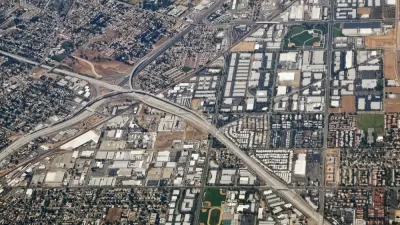The nation's first fuel cell electric train will make its debut in Southern California in about four years, but it's also associated with a controversial ballot measure on the station sites that voters of Redlands will decide on Super Tuesday.

Train service is scheduled to begin in about two years between Redlands and San Bernardino in the region known as the Inland Empire between Los Angeles County and Arizona and Nevada.
Initially, passengers will board diesel multiple units (DMUs) for the nine-mile trip between the two cities in San Bernardino County, but in 2024 the line will operate the continent's first fuel cell electric trains, known as zero-emission multiple units, or ZEMUs. No doubt they will make a sensation as state officials will likely showcase the cutting-edge technology to reduce greenhouse gases in the most-difficult-to-reduce sector, transportation.
However, a strategy that has the potential to greatly further reduce emissions associated with the corridor will be up to the voters of Redlands, a slow-growth city of just over 71,000 people, who will decide on March 3 whether to approve or reject Measure G which would amend the general plan and loosen the city's three slow-growth measures so as to allow for development of transit villages around the three station sites.
NPR aired a 3-minute story about the ballot measure associated with the new train service last Sunday (Feb. 14) on "All Things Considered." Benjamin Purper of KVCR, an NPR-affiliate based in San Bernardino, narrated and wrote the article.
"The core intention of transit-oriented development is to reduce the carbon footprint," says Mayor Paul Foster. "It's to get people out of their vehicles and to walk."
"I think that it will really change Redlands forever. And we'll never be able to get it back," says resident Lane Schneider [and treasurer and principal officer of “Save Redlands — No on G."]
Purper wrote and spoke at greater length on the ballot measure for KVCR on Feb. 18 (listen to his 14-minute report – source article).
Measure G would remove the 400 homes a year restriction from the old slow-growth measures [see impartial analysis [pdf] of the measure].
[Measures U and N and Proposition R] passed in the 70’s, 80’s, and 90’s, limited height and density of residential buildings in an effort to preserve Redlands’ small-town feel.
Purper does an excellent job of getting views from voters on the Yes and No on G campaigns, and from planning academicians as well.
Seva Rodnyansky, a professor of urban and environmental policy at Occidental College, says that transit-oriented development, like what Measure G is proposing to do around the transit villages, does get people out of their cars to some extent.
“I would say that households living near, or in transit-oriented developments, generally speaking, drive quite a bit less at each income swath, you know, anywhere from 10-15 miles less per day, overall, averaged out based on travel survey data per day and that'll translate to a certain amount of greenhouse gas emissions that they're just not producing," Rodnyansky says.
Genevieve Giuliano, a professor of urban planning at the University of Southern California, is a little more skeptical. She says the evidence that transit-oriented development gets people out of their cars is mixed.
“And the reason it's mixed is that a transit-oriented development in Washington, D.C. is something very different from a transit-oriented development in Redlands," Giuliano says.
There's a broader theme playing out in Redlands that should concern all those who want to see greenhouse gas emissions reduced from transportation – there's technology, like electrification (which includes vehicles powered by fuel cells as well as batteries), and then there are the more complex issues surrounding the land use at the train stations that reduce driving, a major reason why these emissions have been increasing in the last five years in California. It may very well prove easier to make progress in the former if voters rebel at the notion of increasing residential density.
Look for the election outcome after March 3 in the comment section below.
Related in Planetizen:
-
Train Buffs: Do You Know What a ZEMU Is? May 1, 2018
FULL STORY: With Measure G, Redlands Joins The Debate Over Housing And Transit-Oriented Development

Planetizen Federal Action Tracker
A weekly monitor of how Trump’s orders and actions are impacting planners and planning in America.

San Francisco's School District Spent $105M To Build Affordable Housing for Teachers — And That's Just the Beginning
SFUSD joins a growing list of school districts using their land holdings to address housing affordability challenges faced by their own employees.

The Tiny, Adorable $7,000 Car Turning Japan Onto EVs
The single seat Mibot charges from a regular plug as quickly as an iPad, and is about half the price of an average EV.

With Protected Lanes, 460% More People Commute by Bike
For those needing more ammo, more data proving what we already knew is here.

In More Metros Than You’d Think, Suburbs are Now More Expensive Than the City
If you're moving to the burbs to save on square footage, data shows you should think again.

The States Losing Rural Delivery Rooms at an Alarming Pace
In some states, as few as 9% of rural hospitals still deliver babies. As a result, rising pre-term births, no adequate pre-term care and "harrowing" close calls are a growing reality.
Urban Design for Planners 1: Software Tools
This six-course series explores essential urban design concepts using open source software and equips planners with the tools they need to participate fully in the urban design process.
Planning for Universal Design
Learn the tools for implementing Universal Design in planning regulations.
Smith Gee Studio
City of Charlotte
City of Camden Redevelopment Agency
City of Astoria
Transportation Research & Education Center (TREC) at Portland State University
US High Speed Rail Association
City of Camden Redevelopment Agency
Municipality of Princeton (NJ)




























